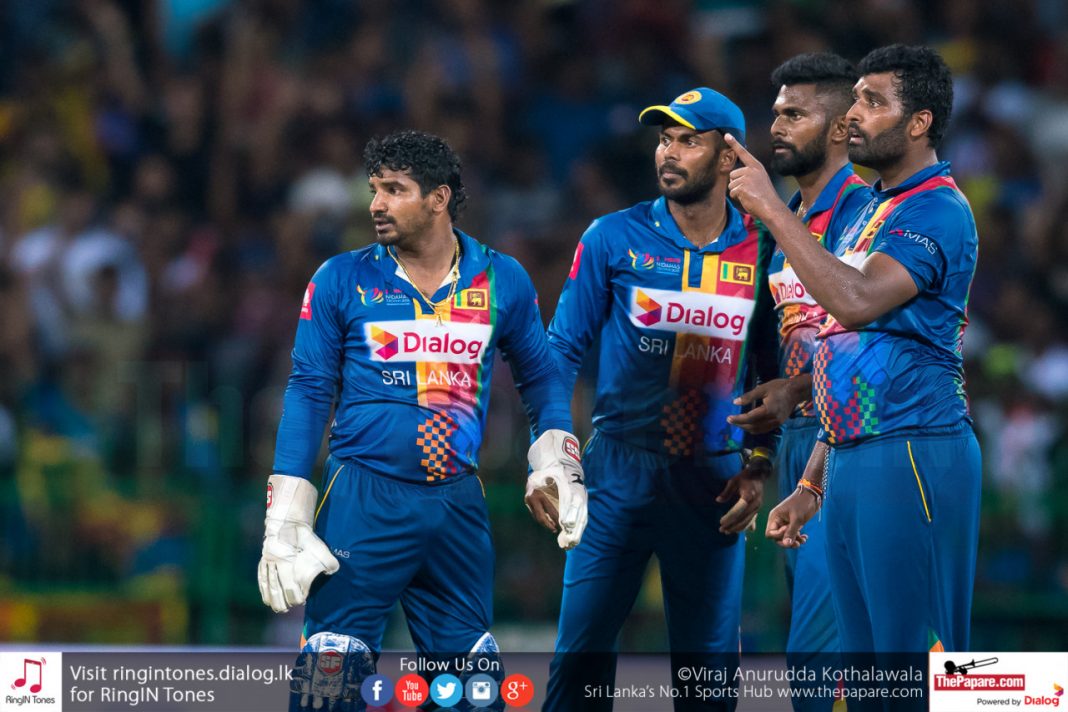The Nidahas Trophy tri-nation tournament was full of disappointment for the local fans although Mr. Karthik gave us some relief in the end. Against a second string Indian side and a tenth ranked Bangladesh, you would have expected Sri Lanka to at least reach the finals. Failure to qualify for the finals showed that Sri Lanka have serious problems to address in the shorter formats of the game. With two visiting teams competing in the final, Sunday’s game was like Hamlet without the Prince of Denmark.
[rev_slider LOLC]
Watching from outside, you wonder whether Sri Lanka made a few tactical blunders. The first three games were played on flat decks and produced high scoring games. When Sri Lanka chased down a target of 175 against India in the curtain-raiser of the competition, it was the highest run chase at the venue.
Then they nearly won again after setting Bangladesh a target of 214. After Bangladesh’s record run chase, it looked as if Sri Lanka pressed the panic button. For the second round games, instead of continuing to play on new decks, they went back to playing on used surfaces. By doing so, they may have played into the hands of the opposition.
Of the three participants, Sri Lanka had the weakest bowling line-up. Both India and Bangladesh were stronger than Sri Lanka whether it was pace or spin. While in the first half of the competition, even good bowlers like Yuzvendra Chahal and Mustafizur Rahman were carted around the park, for the second phase, once the games were played on used surfaces, they started purchasing some assistance.
With the exception of Thisara Perera and maybe Dasun Shanaka, Sri Lanka don’t have many players who could hit the ball a mile. Most batsmen are timers. So when bowlers started getting more assistance from the surfaces in the second half of the competition, the batters found themselves behind the eight ball. The two visiting teams exploited the conditions better in the second phase on used wickets.
Mustafizur, in particular, bowled a couple of dream spells. The way he attacked the Sri Lankans in Friday’s eventual semi-final was a treat to watch while he almost won the final by delivering a maiden over in the 18th over of the innings.
Some selections were bizarre and made no sense as well. Two-dimensional players is a buzz word that is being used in Sri Lankan cricket circles these days. It seems that the management is keen to rely heavily on players who could both bat and bowl. This is the recipe that England tried in mid-1990s in order to address their limited overs cricket woes. They banked heavily on players who could do ‘bit of both’ and picked the likes of Adam Hollioake, Mark Ealham and Matthew Fleming for ODIs. This formula was to give them the best chance in the 1999 World Cup that they were hosting.
But what followed was absolute disaster as England were knocked out of the first round itself in their own World Cup.
With what purpose that Jeewan Mendis was picked at the age of 35 to represent Sri Lanka is beyond our comprehension – especially given that he had last represented Sri Lanka three years ago. He has not done exceptionally well in domestic cricket either to earn a recall and was badly exposed when put under pressure with the bat.
With the team struggling, Mendis had a perfect stage to prove his mettle with the bat, but he lacked both skills – maneuvering the bowling and picking up singles and twos as well as clearing the boundary.
A lot of stress has been placed on leg-spin when it comes to limited overs cricket by coaches these days. The reason for this is that a finger spinner has to rely heavily on assistance from the surface to turn the ball while a wrist spinner can do it all by himself. For ICC events, you expect nothing but flat tracks and teams are heavily banking on leg-spinners.
If you look at the ICC Rankings, among the top ten bowlers in ODI cricket, there are three leg-spinners and in T-20s, their impact is even more as top four ranked bowlers are wrist spinners. So the relevance of wrist spin is clear, but Sri Lanka chose the wrong leggie. An attacking leg-spinner like Jeffrey Vandersayor even Chinaman bowler Lakshan Sandakan would have been the better option.
Of course, it has to be mentioned here that Vandersay has not helped his case. His injuries have taken more time to heal and then he went and got married during a busy season before taking a couple of weeks off the game. With the experiment of Wanindu Hasaranga not working, the selectors would have been forced to fall back on Mendis.
After conceding a record 215 runs against Bangladesh, in a bid to beef up the bowling, Sri Lanka went with one batsman short and that saw them playing Dasun Shanaka at number five followed by Jeewan Mendis at number six. That was another terrible miscalculation and Sri Lanka paid a heavy price.
Sometimes, Independence Cups don’t bring you the success that you look for. In mid-1990s, all three sub-continent countries celebrated their golden jubilee of Independence by playing a cricket tournament. Sri Lanka at least reached the finals of their event where they lost to India despite a magnificent hundred by Aravinda de Silva in 1998. India and Pakistan failed to reach the finals of their own Independence Cup in 1997. Sri Lanka won India’s Independence Cup beating Pakistan in the finals while South Africa won Pakistan’s Independence Cup beating Sri Lanka in the finals. Let’s call it the Independence Cup jinx that even Hathurusingha can’t decode..














